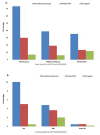Contextualizing Canada's hepatitis C virus epidemic
- PMID: 35992621
- PMCID: PMC9202764
- DOI: 10.3138/canlivj.2018-0011
Contextualizing Canada's hepatitis C virus epidemic
Abstract
In 2016, Canada signed on to the World Health Organization (WHO) 2030 hepatitis C virus (HCV) disease elimination targets. Most of Canada's HCV disease burden is among five disproportionately affected population groups: 1) Baby boomers, who are at increased risk of dying from decompensated cirrhosis and hepatocellular carcinoma and for whom one-time screening should be recommended to identify those undiagnosed; 2) People who inject drugs (PWID), whose mortality risks include HCV infection, HCV acquisition risks and co-morbid conditions. While HCV infection in PWID can be effectively cured with direct-acting antivirals, premature deaths from acquisition risks, now exacerbated by Canada's opioid crisis, will need to be addressed to achieve the full benefits of curative treatment. PWID require syndemic-based solutions (harm reduction, addictions and mental health support, and management of co-infections, including HIV); 3) Indigenous populations who will require wellness-based health promotion, prevention, care and treatment designed by Indigenous people to address their underlying health disparities; 4) Immigrants who will require culturally designed and linguistically appropriate services to enhance screening and engagement into care; and (5) For those incarcerated because of drug-related crimes, decriminalization and better access to harm reduction could help reduce the impact of HCV infections and premature mortality. A comprehensive prevention, care and treatment framework is needed for Canada's vulnerable populations, including those co-infected with HIV, if we are to achieve the WHO HCV elimination targets by 2030. The aim of this review is to describe the HCV epidemic in the Canadian context.
Keywords: Canada; HIV; Indigenous people; baby boomers; epidemiology; hepatitis C virus; immigrants; incarceration; people who inject drugs.
Copyright © 2018 Canadian Association for the Study of the Liver.
Conflict of interest statement
MK has received contract funding paid to his institution from Roche, Hologic and Siemens unrelated to this work. DC and NJ have nothing to disclose.
Figures






References
-
- Krajden M, Yu A, Cook D, et al. Hepatitis C virus (HCV) mortality patterns in the British Columbia Hepatitis Testers Cohort (BC-HTC). Hepatology. 2015;62(S1):252A.
Publication types
LinkOut - more resources
Full Text Sources
